DUEL At 50: Spielberg’s Car Chase Thriller Speeds Across Nixon-Era America
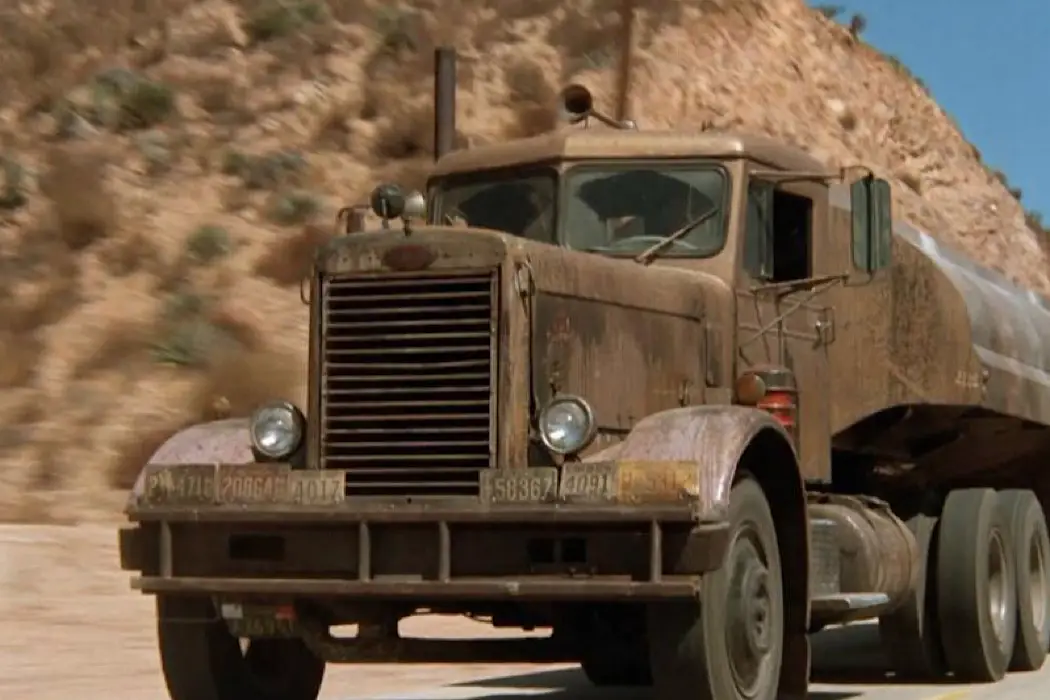
Film critic, Ithaca College and University of St Andrews graduate,…
Steven Spielberg’s career began with a car crash. Or more accurately, with a chase. On November 13, 1971, Duel was released, first on television and then with added footage as a 90-minute theatrical film. For the director, who was previously known for work on television series, his feature debut was a hit, one that cemented him as a major new figure in Hollywood.
Like an early demo reel, Duel featured themes and stylistic flourishes that would become hallmarks for Spielberg. The stunt driving would become more elaborate in The Sugarland Express, and then machine guns and Nazis would be added for Raiders of the Lost Ark. The reliance on suspense, specifically in one-shot scenes, would later recur in Saving Private Ryan and Minority Report. The evil tanker truck as an enormous, unstoppable force of nature preceded the shark in Jaws and the T-Rex in Jurassic Park. And the everyman main character, here played by Dennis Weaver, would remain a staple element of Spielberg’s filmography.
Today, his story of an ordinary businessman terrorized by a psychotic trucker remains a cult classic, not just as “the first Spielberg film,” but as a well-made motion picture in its own right. The stripped-down, bare-bones thriller continues to be celebrated as a showcase of the precise editing, suspenseful storytelling, and economic direction that would define Spielberg’s larger-budget work in Hollywood. He still references the film, which he shot in 12 days, as the fastest he could crank out a movie. But beneath the hood, there’s more to Duel than a simple car chase film. Spielberg’s debut, which premiered on television 50 years ago, is covertly a high-and-low story about Nixon-era America and a fight for dominance along class lines.
Ceci N’est Pas Une Voiture
Most of Duel is set in the vast, xeric expanse of the Mojave Desert, which straddles California, Nevada, Utah, and Arizona. There’s a quintessential Americana to its dry, washed-out rural environment. Duel’s America is one of roadside diners, cowboy hats, and wide-open highways, a setting not unlike those of Terrence Malick’s 1973 debut Badlands, Spielberg’s 1974 film The Sugarland Express, or even 2020’s Best Picture-winning Nomadland. It’s the setting a filmmaker uses when they want to capture “Middle America,” or what’s more derisively referred to as “flyover country.”
But Duel doesn’t start in the desert. We open on the POV of a car leaving a garage in urban California and wending into the desert— it’s the original dashcam film, just five minutes of POV driving with no dialogue and no glimpse of our hero. It’s a ballsy way to start what’s otherwise a pretty cut-and-dry thriller picture, and it’s our first indication that Duel is aiming its sights a little higher. In giving the camera’s perspective to the hood of the car, the cinematography (from Jack A. Marta) gives the vehicle agency. Marta’s camerawork subtly remarks on the rise of consumerist culture throughout the second half of the 20th century and how people can become their possessions. Our social standing and self-worth is, even more so today than it was 50 years ago, tied up inextricably with the stuff we own.
So much of Duel’s plot relies on this framework, on the understanding that a car is not just a car. The hero vehicle is a bright red Plymouth Valiant, and the iconic, villainous truck is a diesel-guzzling, smoke-spewing, rusted-up Peterbilt 281 tanker. Without any dialogue or snazzy camera angles, you can infer immediately which is our protagonist and which is our antagonist.
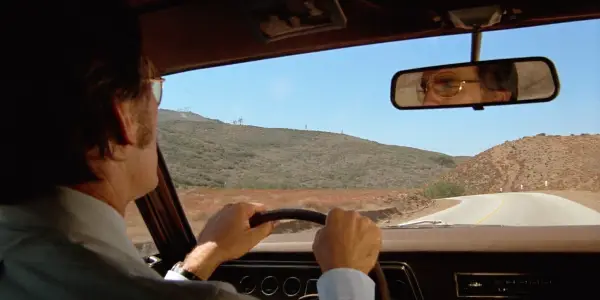
You can think of Duel as a modern Western because it borrows so much of that visual language and so many of those archetypes. The lone, intrepid cowboy and the pugnacious, mysterious criminal in town travel through an anarchic land with no law enforcement around for miles. Were it not for the railroads or highways carving up the desert, it’d look right out of a John Ford film. Duel even concludes with a good-versus-evil showdown on the side of a cliff.
The script, adapted by Richard Matheson from his own short story, prefers action over dialogue. Occasionally we meet some supporting cast, or our hero has a panicked internal monologue that feels like it’s from a European arthouse film. But otherwise, Duel is practically a silent film.
That sparseness means that we learn very little about our characters, and it also elevates them into the realm of allegory. It helps that the truck driver is never named and that the protagonist is named David Mann; it doesn’t take a genius to clock the obvious thematic territory that broaches, from Biblical stuff to explorations of masculinity. Yet the overwhelming allegory of Duel is one of class struggle, as every character, especially our dual leads, represents a specific slice of working-class identity.
That’s all teed up by the film’s setting — in particular, the sequence in the roadside stone diner, Chuck’s Café, reminds me of the endless number of noxious New York Times stories from 2016 through 2020, wherein journalists traveled to the Midwest or to the South to interview white working-class Americans and find out why they ardently supported President Donald Trump. Reporters visited diners, farms, churches — it felt like they sought some elusive journalistic proof, maybe a manila folder tucked away in someone’s shed, or a magic charm hidden behind the waffle maker in a bed and breakfast, anything solid and concrete to rationally explain the phenomenon of Trumpism.
In a way, that’s what Spielberg is doing with Duel. He shot the film in the midst of Richard Nixon’s tenure. The president had won the 1968 contest over Democrat Hubert Humphrey and far-right segregationist George Wallace. Nixon won support from much of the Mid- and Southwest, including California (the state wouldn’t flip blue until 1992). To Nixon, this base of support was the “silent majority.” This body of rural and suburban white working-class Americans is all over Duel, from the diners to the gas stations to the driver’s seat of a Peterbilt 281.
Class Struggle, Italian Style
After Duel performed well on television, Universal Pictures asked Spielberg to shoot several new scenes for a theatrical release overseas. Among those were that stellar opening, as well as an altercation at a railroad crossing and a long sequence where Mann stops to help un-jam a school bus.
When promoting the new, refurbished film, though, Spielberg got frustrated. All of these European critics kept finding sociopolitical subtext in Duel. Italian critics stormed out of a press conference after Spielberg refused to entertain their questions about class struggle. He had made a film about a truck threatening to kill a man on the highway — at best, he thought of it as a parable of man versus machine and little else.
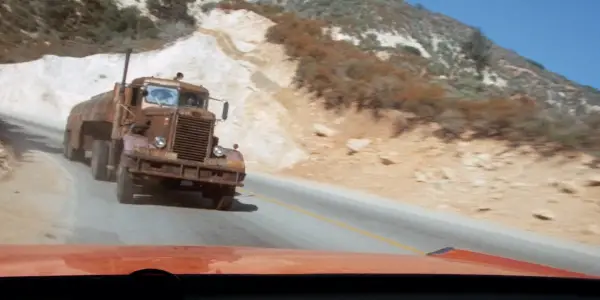
Spielberg was wrong, of course, albeit in the way that most directors aren’t equipped to dissect their own work. The class consciousness is baked into the film from the get-go. Our first patches of dialogue, long before Weaver speaks, come courtesy of sound designers Edwin S. Hall and Sam Caylor, who soundtrack the opening minutes with chopped-up bits of talk radio. Among those are a man calling into a census office to ask about his form. “I don’t mind being counted as an American,” the guy on the radio says. “I’m one of the silent majority.” He’s a reluctant househusband, we learn, upset that his wife is the breadwinner. This invocation of Nixon’s silent majority not even five minutes into the picture practically begs us to watch the rest of the film with a keen eye on class.
This radio interview — which, the screenwriter says, is apparently a bit on a comedy broadcast, though that’s impossible to tell — resonates with Mann. It’s the only program he doesn’t immediately switch off, and later, we can detect some similar misogynist anxieties in the character, and he begins to quote the broadcast nearly verbatim, like how The Dude in The Big Lebowski just repeats things other people say. When a gas station attendant tells him he’s the boss, Mann quips back, “Not in my house, I’m not,” practically parroting the guy from the radio. Would Mann, too, proudly count himself among the silent majority?
In the late 1960s, terms like “Middle American” and “heartland” gained popularity to describe a nebulous American moral center. The term means only what you want it to mean for the time. The Middle American, like the silent majority, is, of course, bullshit, little more than a cheap dog-whistle to refer to conservative white working-class people who staunchly opposed the civil rights movement. In framing conservatism as the middle ground, too, the phrase normalizes the far-right policies of Wallace and his segregationists — in the context of the Middle American, these racists aren’t radicals; they’re just right of center. The Middle American label constitutes a population defined by opposition: In a Time magazine story from 1970, when the Middle American was named Person of the Year, the editors wrote that this group experiences anxiety stemming from newly gained civil rights for African-Americans, as well as second-wave feminism and the growing anti-war movement. They think, according to Time, that the president would be better off soliciting advice from farmers than from Washington bigwigs and scientists, yet they also celebrate that we put a man on the moon.
It’s worth noting that nearly every journalist, pundit, and politician who invokes Middle America or the heartland have never f*cking been to Middle America. Fox News’ Tucker Carlson, who uses the terms constantly, was born in California, studied in New England, and lives in Washington, D.C., and he’s a good deal richer than most of the people whose class interests he claims to represent. Even Nixon, the supposed champion of the silent majority, was also born in California, attended Duke University, and then returned to California to serve as senator. They all avoid the middle of the country.
With the title “Duel,” one anticipates two forces, diametrically opposed. Weaver’s character certainly represents much of what the so-called Middle American would despise — he lives in a city in California, wears trendy suits and glasses, has a luxurious red car, and represents the excess, hubris, condescension, and peac*cking that comes with new money. As seen in the phone conversation with his wife (also added in re-shoots), Mann is a soft pen-pusher cuckold. He couldn’t even stand up for his wife when she was being harassed by another man at a party. The rarely glimpsed trucker, on the other hand, is a muscular white guy who wears snakeskin boots and a cowboy hat, and that’s about all we know about him. He barely talks — a man of action rather than empty conversation. Rugged masculinity versus the beta schmuck from the big city.
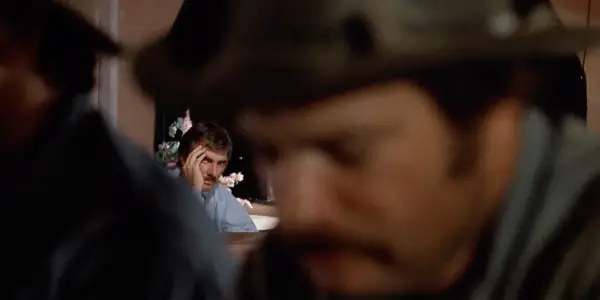
Yet where Italian critics might have pulled at a Marxist vein in the narrative, interpreting the story as a proletariat-versus-bourgeois story of interclass conflict, Mann isn’t exactly Howard Hughes. Duel, instead, seems to me a story of intraclass conflict, a dramatization of the identity crisis among white working-class Americans in the 1970s between poor rural workers and novus homo urban liberal intellectuals.
Mann and the truck driver probably voted the same man into office. They could likely bond over their misogyny and their contempt for bosses. Mann’s just another guy on the payroll, same as the truck driver, but Mann’s playing at nouveau riche with his expensive car, ritzy shades, and holier-than-thou attitude toward the rural people he encounters.
There Is No “Middle America”
In May 1970 in Manhattan, around 1,000 students protested the Kent State shootings and the U.S. invasion of Cambodia. Some construction workers, who had been nearby, converged on and attacked the students. In this and similar demonstrations, white-collar workers put on construction hats and joined the anti-protesters, seizing the opportunity to beat up a bunch of liberal, anti-establishment college students. What I’m suggesting is that, in Duel, the truck driver would have been the one to start a fight, while Mann would have donned a hard-hat and followed suit. They have so much in common that, had they just sat down and talked instead of aggressively chasing one another down the road for a day, they might have sorted this out. (That is, unless the trucker is a maniac. It’s hard to explain class solidarity to a maniac.)
Spielberg’s film capitalizes on the arbitrariness of the “Middle American” — it’s set in the Southwest, after all, hardly the middle of anything. But that’s the beauty of the term: It’s not a definitive concept, it’s a political project. It can mean whatever you want it to mean at the time. In the Nixon era, it meant white racists who opposed the Civil Rights movement and wanted to beat up hippies. And now, the term means… well, it means basically the same thing. Some things don’t change, I guess.
Not only is the term “Middle America” complete political hogwash, but it’s purposefully disingenuous to the real racial character of the country. The center of America isn’t white, but multiethnic. But the Middle American has to be white, because “opposing change” is code for “white flight because nonwhite people are moving into the cities and the coasts.” Like the “Heartland” and jello salads, it was a PR product of the 1960s, a signifier for whiteness without much substance to it.
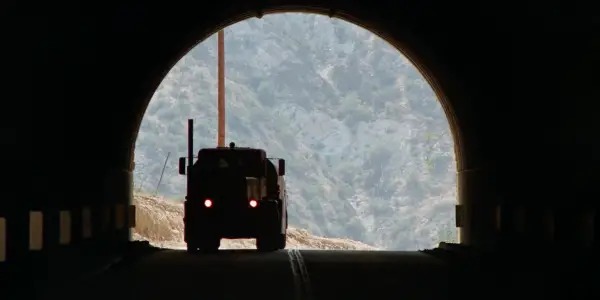
Because of the racial connotations of Duel’s story, a modern remake might recast Denis Weaver with a Black actor. (I’m frankly surprised that this wasn’t made in, like, the ’90s.) It would solve one of the major mysteries of Duel: the motive. Why does the trucker pursue Weaver so relentlessly and viciously? (If you’re an Italian critic, of course, you’ve figured it out, but it’s never spelled out explicitly in the story.) A psychoanalytic or gendered reading of Duel might posit that it’s the action of overtaking him on the highway, a challenge to the driver’s masculinity, that results in the madness, while I suppose the most simple answer is just that the trucker is crazy.
But I think the secret lies in that damn awful Time magazine story, which emphasizes that the Middle American is a figure of normative opposition. Every scene in the film reinforces how much of an outsider Mann is, and therefore the trucker opposes him.
After that, things get uncomfortable. Because though they’re likely of the same social class in a Marxist sense, living under the heel of the boss’s boot and the bottom line, the film clearly expects you to align the driver in your head with some monstrous rural white American cliché, a backwoods (back-desert?) uneducated Bob Ewell–type. In the diner scene, Mann reduces the truck driver to just his snakeskin boots, scanning the footwear of the diner-goers, trying to spot the pattern. That diner scene reinforces the notion of the Middle American, equating the driver with an anonymous American man — no face, no voice, just a pair of boots and a truck.
In facing his smoke-spewing metal Goliath, Mann compares the experience in his voiceover to a primitive awakening, saying that it’s brought him “back to the jungle once more.” If symbolically, Mann’s car represents wealth, style, pleasure, and fashion, then what does it mean that the car is deconstructed throughout the film? That it’s scuffed-up, dirtied, dented, smashed against a fence, the radiator hose gives, the fender is knocked, and in the end, it’s crashed into a rock wall and then pushed off a cliff and destroyed? Is Spielberg suggesting that class divisions are a farce, that at the core of human beings, there’s a paleolithic drive to hunt, kill, and conquer that will always form our most basic, basest instincts?
Conclusion: What Did We Learn, David?
It’s easier to portray the trucker as a devil figure, silhouetted in the cave, revving his engine to charge Mann, or wildly driving his truck between live snakes, trying to kill the businessman in the phone booth. It’s easier still for Spielberg to code the trucker as the Middle American out of the two of them, given that trucking is already seen to be a somewhat disgraceful albeit necessary “dirty job.” Duel’s political dimensions are complicated by Spielberg’s shortcomings as a dramatist. That the film is remembered for its technical achievements is a big disappointment; any political readings of Duel have been diminished significantly as cinephiles and Spielberg scholars have plowed the film over for its technical merits alone.
Ultimately, though there’s plenty of sociopolitical and economic themes to mine in Duel, the film seems uninterested in encouraging these lines of inquiry. It’s a full-speed-ahead chase film about a businessman who’d rather be on time than be respectful, and for many viewers, that’s about it. But if you look under the hood, you’ll find a labyrinth of commentary on class, race, politics, and masculinity. A whole engine of symbolism purring along. A thesis on class unity, about divisions along lines of whiteness, about how the premise of Nixon’s campaign was actually just a bunch of nonsense that preyed not just on white fears of racial equality, but also on white fears of socioeconomic equality. To David, the trucker belongs to a primitive world, the desert, while he belongs in the glistening city upon a hill.
Duel made Spielberg a director to watch, and it lined him up for a number of projects after it, but its most important contribution to Spielberg’s oeuvre is the gloss of the blockbuster. In creating popular entertainment for television broadcasting, Spielberg managed to covertly sneak in political messaging. That’s the beauty of the blockbuster: the sinister Trojan Horse of ideas. Even if Spielberg doesn’t realize that that’s what he was doing.
Do you enjoy Duel? What are your opinions of Steven Spielberg’s debut? Leave us a comment below.
Does content like this matter to you?
Become a Member and support film journalism. Unlock access to all of Film Inquiry`s great articles. Join a community of like-minded readers who are passionate about cinema - get access to our private members Network, give back to independent filmmakers, and more.
Film critic, Ithaca College and University of St Andrews graduate, head of the "Paddington 2" fan club.













